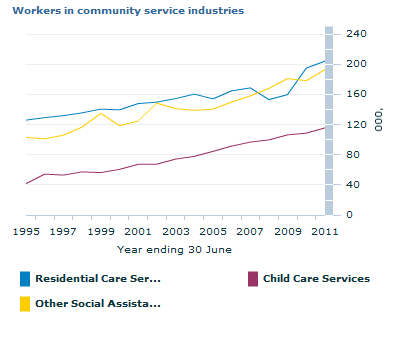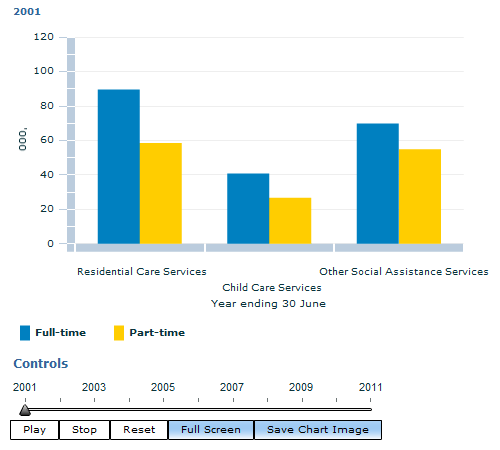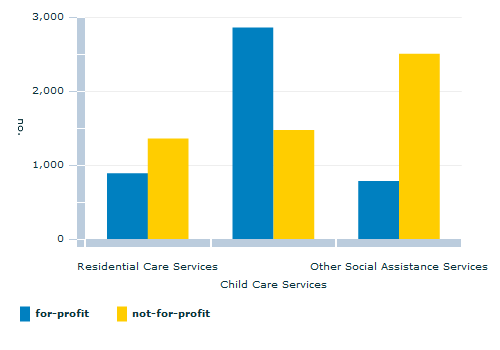4102.0 - Australian Social Trends, Sep 2011
ARCHIVED ISSUE Released at 11:30 AM (CANBERRA TIME) 21/09/2011
Page tools:
 Print Page Print Page
 Print All Print All
| |||||||||||||||||||||||||||||||||||||||||||||||||||||||||||||||||||||||||||||||||||||||||||||||||||||||||||||||||||||||||||||||||||||||||||||||||||||||||||||||||||||||||||||||||||||||||||||||||||||||||||||||||
CONTENTS Article - Introduction - How many people work in community service industries? - Who are they? - What are their working arrangements? - What jobs do they perform? - How much do they earn? - Future directions Additional topics - Community service providers Further information - Data sources and definitions - Endnotes This will be replaced by the swf.  INTRODUCTION The community services sector is vital to sustaining the wellbeing of communities in Australia. Community service workers not only provide aged care and child care services that benefit many Australians, they also provide welfare and support services to assist some of the most vulnerable people in the community. These services often complement those provided by family members and volunteers. Recent and ongoing changes in Australia have placed increasing demands on the community services sector. Changes in society, particularly the growth in women’s workforce participation, have resulted in greater demand for child care and after school care services. (Endnote 1) Similarly, the ageing of Australia’s population has resulted in an increasing proportion of the population in need of aged and residential care services. (Endnote 2) As demands placed on community services evolve, so to do the demands placed on workers providing these services. Dealing with potential workforce shortages is expected to be a key challenge for the aged care and child care industries in the future. Moreover, as expectations of the types of community services provided change, (Endnote 2) the need for workers to be adequately equipped and qualified to meet these changes grows. This article presents an overview of workers in industries that provide residential care services, child care services and other social assistance services in Australia. HOW MANY PEOPLE WORK IN COMMUNITY SERVICE INDUSTRIES? The past decade has seen substantial growth in the number of people employed in community service industries. Between 2000-01 and 2010-11, the number of people employed in community service industries grew 51% compared with 26% for all industries. The number of people working in community service industries went from an average 340,000 workers in 2000-01 to 513,000 in 2010-11. While growth was reflected across all community service industries, some of these industries grew more rapidly than others. The number of people employed in the Child Care Services industry grew by 72% between 2000-01 and 2010-11, while in the Other Social Assistance Service industry and the Residential Care Services industry, the number grew by 55% and 38% respectively. In 2010-11, there were an average half a million people (513,000), or 4.5% of all employed people, working in community service industries. Workers in the Residential Care Services industry comprised the largest group (204,000 people), followed closely by the Other Social Assistance Services industry (193,000). The Child Care Services industry was smaller, employing 116,000 people. WHO ARE THEY? Mostly women Women form the majority of people who work in community service industries. In 2010-11, women represented 84% of workers in community service industries, compared with 45% of workers in all industries. In the Child Care Services industry, 96% of those employed in 2010-11 were women. In the Residential Care Services industry, women comprised 86% of workers, while in the Other Social Assistance Services industry, three-quarters (75%) of those employed were women. WORKERS IN COMMUNITY SERVICE INDUSTRIES BY SEX - 2010-11 This will be replaced by the swf.  Mostly older The age profile of workers in community service industries also differs considerably from that of workers employed in all industries. The age profiles of the Residential Care Services industry and the Other Social Assistance Services industry are similar in that older workers constitute a large proportion of the overall workforce. In 2010-11, more than half of Residential Care Services workers (58%) and Other Social Assistance Services workers (54%) were aged 45 years and over compared with 38% of workers in all industries. In contrast, people working in the Child Care Services industry tended to be much younger. In 2010-11, 27% of workers in this industry were aged 15-24 years despite this age group representing just 17% of those employed in all industries. WORKERS IN COMMUNITY SERVICE INDUSTRIES BY AGE GROUP- 2010-11
Recent years have seen greater attention paid to workforce ageing and its potential to exacerbate skills and labour shortages in some health and community service industries. (Endnote 4) Between 2000-01 and 2010-11, there was substantial ageing of workers in the Residential Care Services industry. Notably, the proportion of workers aged 55 years and over increased considerably over the decade, more than doubling their share from 11% in 2000-01 to 27% in 2010-11. During this same period, there was a substantial decline in the proportion of workers aged 25-34 years and 35-44 years. WORKERS IN THE RESIDENTIAL CARE SERVICE INDUSTRY BY AGE GROUP This will be replaced by the swf.  Source(s): ABS Labour Force Survey Although some workforce ageing was also in the Other Social Assistance Services industry, this ageing was more modest. Between 2000-01 and 2010-11, the proportion of workers in the Other Social Assistance Service industry aged 55 years and over increased 11 percentage points (from 14% to 25%), compared with six percentage points for workers in all industries (from 11% to 17%). Qualifications While workers in community service industries in May 2010 were more likely to have educational attainment at a Year 12 level or higher than people employed in all industries (82% compared with 76%), they were less likely to have completed a bachelor level degree or higher (20% compared with 26%). Even after taking into account the effect of different age profiles, these differences were still evident. However, workers in community service occupations were more likely to be enrolled in some form of study than people employed in all industries. In May 2010, 20% of community service workers were engaged in formal learning during the year, compared with 15% for workers in all industries. Moreover, this proportion for community service workers increased when adjusted to account for differences in age. The large proportion of young people working in the Child Care Services industry meant that the educational characteristics of this workforce differed from those working in other community service industries. In May 2010, 88% of workers in Child Care Services had educational attainment at a Year 12 level or higher, and 28% were currently enrolled in some form of study, nearly twice the proportion for people employed in all industries (15%). WHAT ARE THEIR WORKING ARRANGEMENTS? Although full-time work is the most common working arrangement for people employed in all industries (70%), workers in community service industries were just as likely to work part-time as they were to work full-time (51% and 49% respectively). While this in part reflects the high proportion of older workers and women working in these industries, these factors did not account for all the differences seen in working arrangements. After taking into account age and sex differences, workers in community service industries were still substantially more likely to work part-time than workers in all industries. The propensity for a greater proportion of community service workers to work part-time was reflected in the average hours worked by these workers. In 2010-11, workers in community service industries worked an average 28 hours per week, six hours less than the average for people employed in all industries (34 hours per week). While part-time work has generally become more prevalent among all employed people, this trend is particularly apparent in community service industries. Between 2000-01 and 2010-11, the proportion of workers in all industries employed part-time increased three percentage points from 27% to 30%. In the same period, the proportion of community service workers employed part-time increased 10 percentage points, from 41% to 51%. This difference was most pronounced in the Residential Care Services industry where 91% of total workforce growth in this industry was due to an increase in part-time workers. In the other community service industries, this proportion was also high, at 59% and 58% for the Child Care Services industry and the Other Social Assistance Service industry respectively. WORKERS IN COMMUNITY SERVICE INDUSTRIES BY PART-TIME AND FULL-TIME STATUS - 2000-01 AND 2010-11 This will be replaced by the swf.  WHAT JOBS DO THEY PERFORM? Workers in community service industries perform a wide range of roles that not only vary between industries, but also vary considerably within industries. In the Residential Care Services industry, 44% of workers worked as Personal Carers and Assistants in 2010-11. Nurses was the second largest occupation group with 17% of workers working as Midwifery and Nursing Professionals. The remainder of workers in this industry worked in a wide range of support roles. A considerable proportion of those employed in the Child Care Services industry are involved in the direct provision of services. In 2010-11, three-quarters (75%) of those employed in the industry worked as Child Carers. Managers of child care centres was the second largest occupation group in this industry with 8% of workers in this industry working as Education, Health and Welfare Service Managers. The variety in the services offered by the Other Social Assistance Services industry is reflected in the occupations of people who work in this industry. More than a third (36%) of those working in the Other Social Assistance Services industry worked as Personal Carers and Assistants. Social and Welfare Professionals (13%) and Health and Welfare Support Workers (11%) were the other significant occupation groups in this industry. PROPORTION OF EMPLOYED PERSONS IN SELECTED OCCUPATION GROUPS - 2010-11
Source: ABS Labour Force Survey HOW MUCH DO THEY EARN? A recent case brought to the Fair Work Ombudsman has seen greater attention paid to the wages and earnings of workers in community services. (Endnote 5) As demand for workers in some community service industries increases, ensuring that wages are competitive enough to attract and retain workers is a key concern. (Endnote 2) In August 2010, the earnings of full-time employees in community service industries tended to be below the average for full-time employees in all industries. Where full-time employees in all industries earned an average $1,263 per week, full-time employees in community service industries earned around three-quarters this amount ($904 per week). This difference was marked for Child Care Services employees who earned two-thirds the average of employees in all industries ($810 per week). For part-time employees in community service industries, average weekly earnings were similar to the average for part-time employees in all industries, with the exception of the Child Care Services industry. Where part-time employees in all industries earned an average $468 per week, part-time employees in the Child Care Services industry earned substantially less than this amount, at $377 per week. Differences in earnings may reflect a multitude of factors. The hours a person works for example considerably influences their overall earnings. Lower earnings in some industries may also reflect the type of working arrangements of workers, or the types of work performed. These differences should be considered when comparing average earnings. AVERAGE WEEKLY EARNINGS OF EMPLOYEES IN COMMUNITY SERVICE INDUSTRIES(a) - AUGUST 2010
Source: ABS 2010 Employee Earnings, Benefits and Trade Union Membership Survey FUTURE DIRECTIONS In addition to national disability and carer strategies, recent years have seen a range of initiatives aimed at ensuring the continued provision of high quality community services in Australia. In 2009, the Council of Australian Governments (COAG) agreed to a new National Quality Agenda for early childhood education and care and Outside School Hours Care. The purpose of this framework is to see better quality services provided to children in care environments. The implementation of this agreement intends to see, amongst other changes, the movement towards a National Quality Standard for all Australian states and territories. (Endnote 6) In aged care, the Productivity Commission has recently concluded a substantial inquiry into providing care for older Australians. This report has developed a range of policy options that potentially could alter the way in which aged care services are provided and funded in Australia. (Endnote 2) More broadly, the recent establishment of the Office for the Not-for-Profit Sector, and the appointment of the Not-For-Profit Sector Reform Council, aims to see stronger and more productive relationships pursued between not-for-profit organisations and the Government. (Endnote 7) As not-for-profit organisations provide the majority of services in some community service areas, the consequence of these developments could be wide ranging, with lasting impacts on community service workers and the community. ADDITIONAL TOPICS
EXPLANATORY INFORMATION
ENDNOTES 1. More information on child care in Australia can be found in Australian Social Trends June 2010, ‘Child Care’, cat. no. 4102.0. 2. Productivity Commission, 2011, Caring for Older Australians, <www.pc.gov.au>. 3. Productivity Commission, Report of Government Services, (part F.2), <www.pc.gov.au>. 4. Recent publications that have discussed workforce ageing with respect to health and community services include the Community Services and Health Industry Skills Council’s Environmental Scan 2011, the Department of Education, Employment and Workplace Relations’ Employment outlook for health care and social assistance, and the Australian Institute of Health and Welfare’s Health and community services labour force 2006. Workforce ageing was also raised in Australian Social Trends 2004, ‘Community service workers’, cat. no. 4102.0. 5. Fair Work Australia, 18 May 2011, Social & Community Services equal pay case update, viewed 01 September 2011, <www.fairwork.gov.au>. 6. Council of Australian Governments, 2009, Council of Australian Governments’ Communique - 7 December 2009, COAG, viewed 01 September 2011, <www.coag.gov.au>. 7. Office for the Not-for-Profit Sector, 2011, About the Office, viewed 01 September 2011 <www.notforprofit.gov.au>. Document Selection These documents will be presented in a new window.
|
|||||||||||||||||||||||||||||||||||||||||||||||||||||||||||||||||||||||||||||||||||||||||||||||||||||||||||||||||||||||||||||||||||||||||||||||||||||||||||||||||||||||||||||||||||||||||||||||||||||||||||||||||

